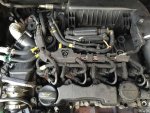Hello over in the dark side!
I am in early contemplation to purchase a car like this:
2007 Citroen C4 HDi Auto
A few weeks ago I did some google research and discovered problems associated with the 1.6Lt HDi engine. Seems to be associated injectors coming loose and allowing blow-by into the cam cover? This causes formation of carbon particles which block the oil galleries, suction strainer etc, and cause turbo and camshaft bearing failures. Seems to be the same engine as used in the BWM mini. If this is a common occurrence, then it is not what I need.
Do the forum members have any comment regarding this problem?
I want the vehicle for my daughter to replace the existing 1.6Lt 307 auto hatch, which is a bit underpowered and also does not have cruise control. She does driving to Uni in Melbourne and once a week comes back to Ballarat. She has been trialling Mrs Whippets 307 touring 2Lt HDi and quite likes the torquey diesel and auto. I thought that the smaller 1.6Lt HDi diesel would have reduced fuel consumption but would still have good torque for in traffic commuting driving. It would also have the reliable 6 Sp Aisin auto. Also have a thumbs up for the all important "looks" of the C4.
Any other comments other than the engine transmission regarding: body, seating, suspension, brakes, instrumentation niggles etc.
If the C4 1.6Lt HDi auto is a non starter, then I will likely investigate acquiring a 307 Hatch 2 Lt HDI 6Sp Auto
Thanks in advanced for your feedback.
I am in early contemplation to purchase a car like this:
2007 Citroen C4 HDi Auto
A few weeks ago I did some google research and discovered problems associated with the 1.6Lt HDi engine. Seems to be associated injectors coming loose and allowing blow-by into the cam cover? This causes formation of carbon particles which block the oil galleries, suction strainer etc, and cause turbo and camshaft bearing failures. Seems to be the same engine as used in the BWM mini. If this is a common occurrence, then it is not what I need.
Do the forum members have any comment regarding this problem?
I want the vehicle for my daughter to replace the existing 1.6Lt 307 auto hatch, which is a bit underpowered and also does not have cruise control. She does driving to Uni in Melbourne and once a week comes back to Ballarat. She has been trialling Mrs Whippets 307 touring 2Lt HDi and quite likes the torquey diesel and auto. I thought that the smaller 1.6Lt HDi diesel would have reduced fuel consumption but would still have good torque for in traffic commuting driving. It would also have the reliable 6 Sp Aisin auto. Also have a thumbs up for the all important "looks" of the C4.
Any other comments other than the engine transmission regarding: body, seating, suspension, brakes, instrumentation niggles etc.
If the C4 1.6Lt HDi auto is a non starter, then I will likely investigate acquiring a 307 Hatch 2 Lt HDI 6Sp Auto
Thanks in advanced for your feedback.


